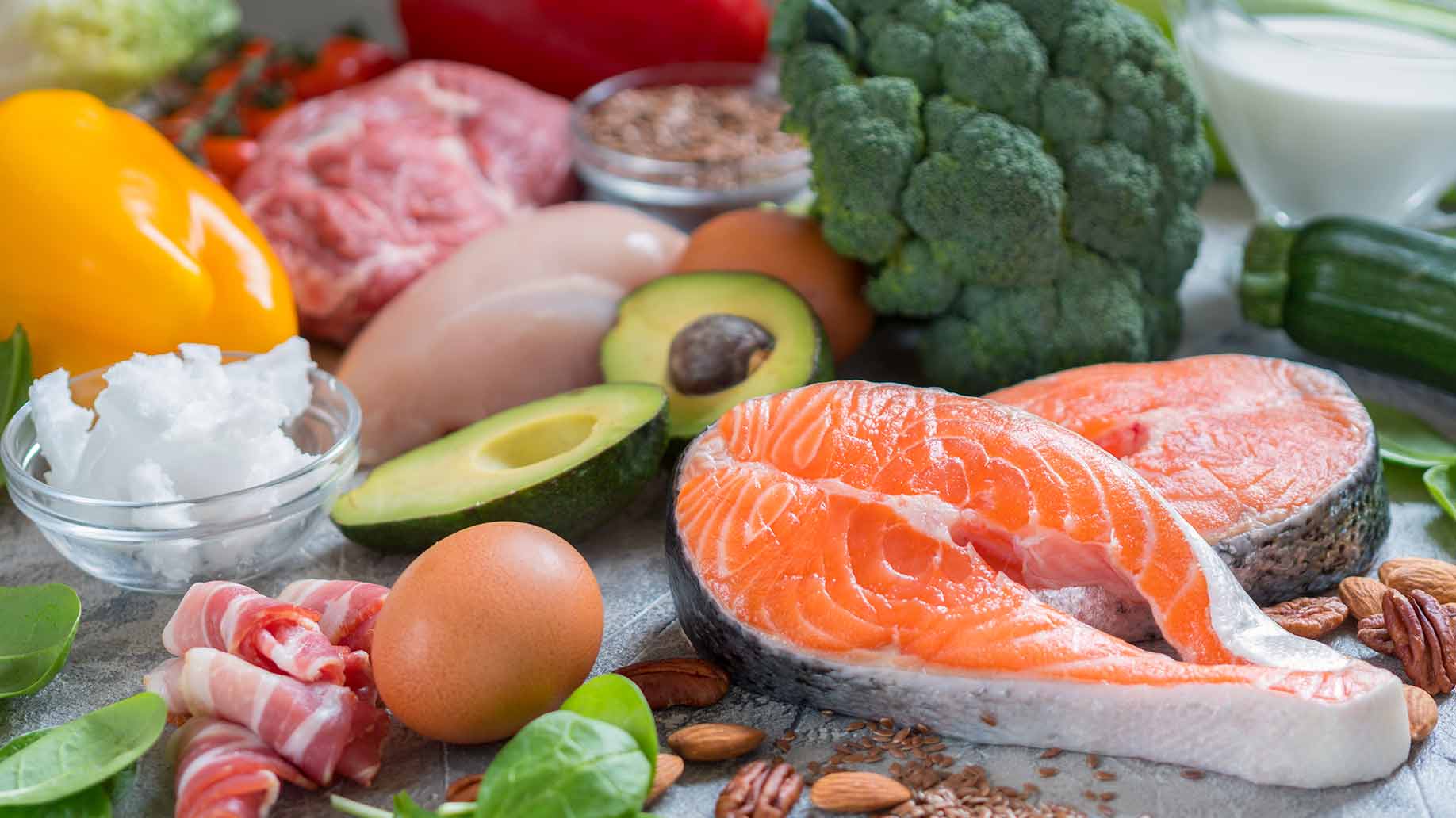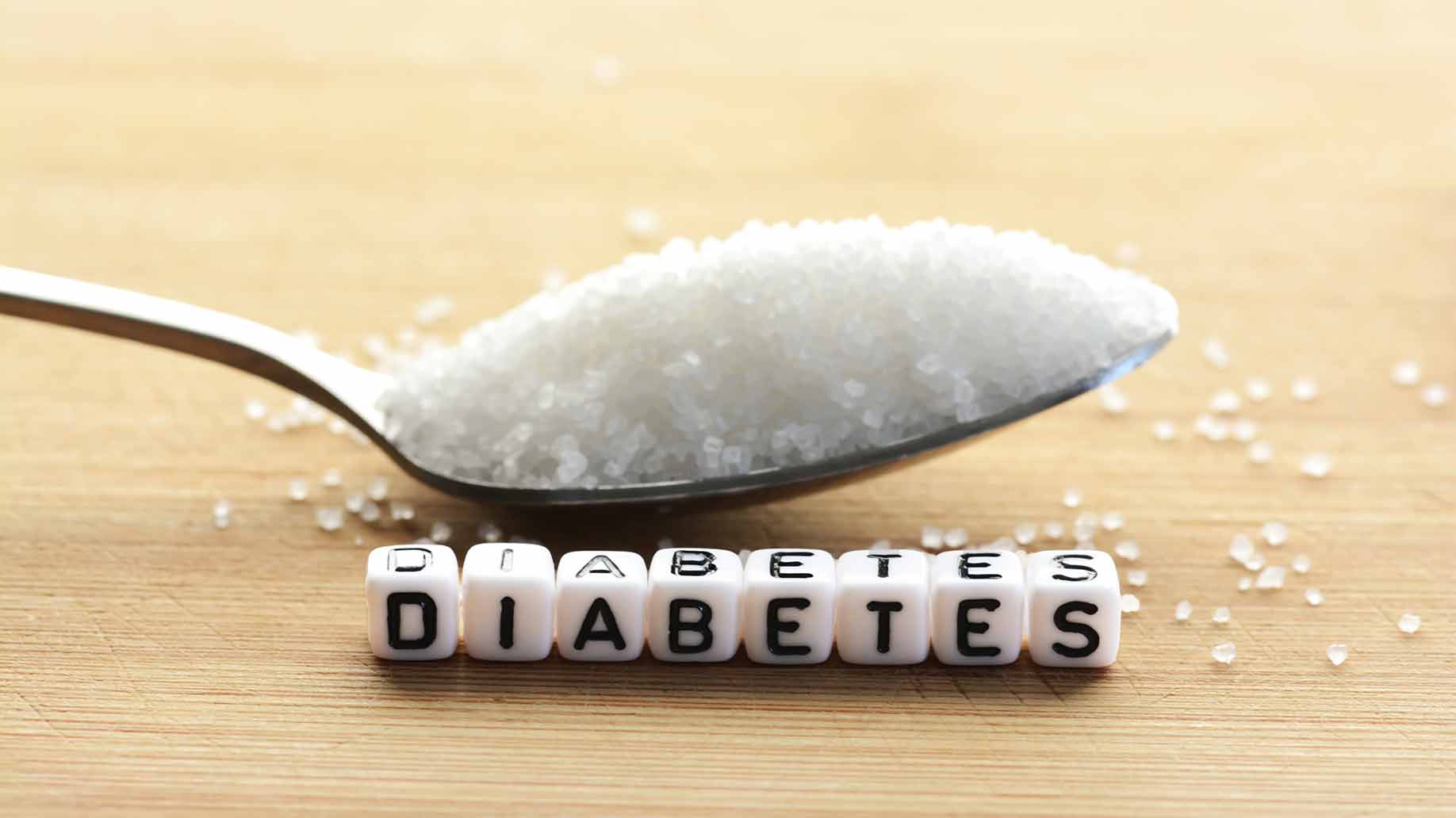According to data from the National Health and Nutrition Examination Survey (NHANES), approximately half the US adult population has diabetes or prediabetes.
The estimated prevalence of type 2 diabetes among U.S. adults is 12-14% and the prevalence of prediabetes is 37-38%. The same data indicates that around 35% of those who have type 2 diabetes have not been diagnosed and 93% of those with prediabetes do not know they have a potential health problem.
Type 2 Diabetes
Type 2 diabetes develops when the cells becomes resistant to the hormone insulin or when the pancreas stops producing enough insulin. When a healthy person eats carbohydrate or sugar, glucose is absorbed into the bloodstream.
The pancreas then secretes insulin which allows glucose to enter the cells. Insulin lowers the level of sugar in the bloodstream. As blood sugar levels drop, the pancreas stops secreting insulin.
In type 2 diabetes, the cells become resistant to the action of insulin and are less able to absorb sugar from the blood. As blood sugar levels rise, beta-cells in the pancreas release increasing amounts of insulin. Eventually, the beta-cells become impaired and can’t make enough insulin to lower blood sugar to healthy levels.
The high levels of blood sugar in type 2 diabetes can eventually lead to heart disease, Alzheimer’s disease, nerve damage, kidney disease, vision problems and foot or leg amputations.
Prediabetes
People are diagnosed with prediabetes if blood tests show that their blood sugar levels are higher than normal, but not in the type 2 diabetes range. According to the CDC, 15-30% of people with prediabetes will develop type 2 diabetes within five years. They are also at higher risk of heart disease and stroke. There are no clear symptoms of prediabetes, so you may be one of the many who have it and may not even know it.
Type 2 diabetes is usually treated with lifestyle changes, oral medications and/or insulin injections. People with prediabetes are usually advised to lose weight, exercise and eat a healthy diet.
There are many natural ways to help keep your blood sugar levels in the normal range and increase your insulin sensitivity. The methods detailed below can help to lower the risk of prediabetes or type 2 diabetes or to reduce the need for medication in those already diagnosed.
Diagnostic Tests
Type 2 diabetes and prediabetes are diagnosed with blood sugar tests. The Mayo Clinic recommends diabetes screening every 3 years for overweight people with additional risk factors and anyone over the age of 45.
Normal Blood Sugar (non-Diabetic)
- 70-99 mg/dL
- A1C (average blood sugar levels over 2-3 months) levels below 5.7 percent
Prediabetes
- Fasting blood sugar level between 100-125 mg/dL
- A1C between 5.7-6.4 percent
Diabetes
- Fasting blood sugar level above 125 mg/dL
- A1C above 6.5 percent
Fasting Plasma Glucose Test (FPF) measures blood sugar levels after an overnight fast.
- Normal – less than 100 mg/dl
- Prediabetes – 100 mg/dl to 125 mg/dl
- Diabetes – 126 mg/dl or higher
A Glucose Tolerance Test (GTT) is used to measure how blood sugars rise and fall after consuming carbohydrates. Blood sugar is measured after an overnight fast. Then blood sugar is measured again 2 hours after drinking a sugary liquid.
- Normal – less than 140 mg/dl
- Prediabetes – 140 mg/dl to 199 mg/dl
- Diabetes – 200 mg/dl or higher
A Glycated Hemoglobin (A1C) test measures the percentage of blood sugar attached to the hemoglobin in red blood cells to determine your average blood sugar level for the past 2-3 months.
- Normal – less than 5.7%
- Prediabetes – 5.7% to 6.4%
- Diabetes – 5% or higher
7 Evidence-Based Ways to Prevent or Control Diabetes
1. Coffee

Coffee contains several phenolic compounds that may help to prevent or treat metabolic disorders. Rodent studies have shown that a major component of coffee, chlorogenic acid, reduces insulin resistance.
Another compound in coffee, quinine, has been shown to lower blood sugar levels in human diabetics and non-diabetics. Trigonelline, a plant alkaloid found in coffee, has been shown to improve glucose tolerance and insulin resistance in human and rodent studies.
A blood protein called sCD163 is a biomarker for inflammation. Research has shown that higher concentrations of sCD163 predict increased risk of type 2 diabetes in the general population.
A Spanish case-control study published in PLoS One examined the influence of diet on sCD163 levels. Researchers compared data from blood samples and food frequency questionnaires collected from 514 type 2 diabetes patients and 517 controls with normal glucose tolerance.
Concentrations of sCD163 concentrations were 11% higher in type 2 diabetes patients than in controls. Researchers analyzed the link between sCD163 and the intake of 30 different foods and beverages. Coffee and red wine were the only dietary items associated with significantly lower levels of sCD163.
A Meta-analysis published in Diabetes Care pooled data from 28 prospective studies with 1,109,272 study participants and 45,335 cases of type 2 diabetes. Duration of follow-up ranged from 10 months to 20 years. The analysis showed that the more coffee participants consumed per day, the lower the risk for type 2 diabetes compared with non-coffee drinkers.
The risk for type 2 diabetes was reduced by:
- 8% for 1 cup of coffee
- 15% for 2 cups of coffee
- 21% for 3 cups of coffee
- 25% for 4 cups of coffee
- 29% for 5 cups of coffee
- 33% for 6 cups of coffee
Both caffeinated and decaffeinated coffee were associated with reduced diabetes risk.
A prospective study published in Diabetologia examined the associations between changes in coffee and tea consumption and risk of type 2 diabetes. Researchers analyzed data from 3 large cohort studies including 95,974 women and 27,759 men. These studies used questionnaires to collect detailed information on diet, lifestyle and medical conditions every 2-4 years for over 20 years.
Participants were asked how many times per day (on average) they had consumed caffeinated coffee, decaffeinated coffee or tea during the previous year. Over the course of the study, participants who reported having type 2 diabetes were followed up to confirm the diagnosis.
The data revealed that participants who increased their coffee consumption by more than 1 cup per day over a 4-year period had a 12% lower risk of type 2 diabetes in the subsequent 4 years compared to those who made no changes in consumption. Participants who decreased their coffee intake by more than 1 cup per day had an 18% higher risk for type 2 diabetes. Changes in tea consumption were not associated with type 2 diabetes risk.
Method: In addition to protecting against diabetes, coffee has many other health benefits. So, if you enjoy it, drink up.
If too much caffeine makes you anxious or keeps you awake at night, switch to decaf. Most of the disease-fighting properties in coffee come from the antioxidants and phenolic compounds, not the caffeine.
Recommended:
2. Magnesium

Magnesium is required for the action of enzymes involved in glucose metabolism. Research has shown that magnesium deficiency may cause disorders of insulin signaling and insulin secretion, leading to impaired insulin sensitivity in muscle cells and fat cells.
In rodent studies magnesium supplementation protects against insulin resistance and reduces the development of diabetes.
A meta-analysis published in Diabetes Care examined the association between magnesium intake and risk of type 2 diabetes. Researchers pooled data from 13 prospective cohort studies involving 536,318 participants. All of the studies assessed magnesium intake using dietary or food frequency questionnaires.
Over a follow-up period ranging from 4-20 years, 24,516 participants developed type 2 diabetes. Analysis of the data showed that type 2 diabetes risk was reduced by 14% for every 100 mg per day increment in magnesium intake.
A longitudinal study followed participants in the Framingham Heart Study to assess associations between magnesium intake and type 2 diabetes. A cohort of 2,582 non-diabetic adults aged 26-81 completed 126-item food frequency questionnaires at three different intervals and this data was combined to determine average magnesium intake from food and supplements. Metabolic impairment was measured with glucose tolerance and fasting blood insulin tests.
In the total study population, there were 179 cases of diabetes over 7 years of follow-up. Participants with the highest magnesium intake had a 53% lower risk of developing type 2 diabetes compared to those with the lowest intake. In those who had prediabetes or some level of metabolic impairment at the start of the study, higher intake was associated with 32% lower risk of developing type 2 diabetes.
A randomized controlled trial published in Diabetes Care tested oral magnesium supplementation for improving insulin sensitivity and metabolic control in type 2 diabetics. Researchers recruited 65 patients with type 2 diabetes who had blood levels of magnesium below the normal range. The subjects were randomly allocated to receive either a magnesium chloride solution or a placebo daily.
At the start and end of the trial, the patients’ blood was tested for blood sugar concentrations, insulin, cholesterol levels and magnesium levels. After 16 weeks, patients who received magnesium had significantly lower fasting blood glucose and significantly lower insulin resistance than the control group.
Method: The best sources of dietary magnesium are fiber-rich plant foods such as nuts, beans and leafy greens. Unfortunately, if intensive farming has depleted the soil of its mineral content, plants grown in it may not provide adequate amounts of magnesium to meet the 400 mg recommended daily value.
Magnesium supplements come in a variety of forms. According to the NIH, magnesium powders and tablets that dissolve in liquid are better absorbed in the gut. Magnesium in the citrate, lactate, aspartate and chloride forms is more bioavailable than magnesium oxide and magnesium sulfate.
Recommended:
3. Curcumin

Curcumin is a polyphenol found in turmeric, the bright yellow spice used in curries and other Asian dishes.
Research has shown that curcumin can protect against type 2 diabetes in several ways. It improves pancreatic cell function, stimulates the release of insulin and reduces insulin resistance. It lowers blood sugar levels by reducing glucose production in the liver. It also activates enzymes that promote cellular uptake of glucose.
A randomized controlled trial published in Diabetes Care assessed the efficacy of curcumin in delaying development of type 2 diabetes. Researcher recruited 240 participants aged 35 and older who had been diagnosed with prediabetes and were not on any medication. Half of the subjects received 250 mg of curcumin capsules and half received placebo capsules. They were instructed to take 3 capsules twice a day.
After 12 months, 19 (16.4%) of subjects in the placebo group had been diagnosed with type 2 diabetes. In contrast, none of the subjects in the curcumin group developed type 2 diabetes over the course of the study. Blood tests showed that the curcumin group had significantly better overall function of insulin-producing pancreatic beta-cells.
Blood levels of free fatty acids (FFAs) are elevated in obese individuals and are associated with decreased increased insulin resistance and pancreatic beta-cell dysfunction. A study published in Molecular Nutrition and Food Research investigated whether curcuminoids benefit type 2 diabetic patients by reducing FFAs. A total of 100 overweight or obese type 2 diabetes patients were randomly assigned to receive 300 mg of curcuminoids per day or a placebo.
After 3 months, patients in the curcuminoids group had significantly lower fasting blood glucose and insulin resistance compared to the placebo group. Curcuminoids also led to a significant decrease in blood levels of FFAs.
A clinical trial at the Mashhad University of Medical Sciences, Iran, tested the effect of a highly bioavailable curcumin supplement on patients with type 2 diabetes. A total of 70 type 2 diabetic patients were randomized to receive 80 mg of nanocurcumin capsules or placebo capsules for 3 months.
Blood sugar and cholesterol levels were checked before and after the trial. The curcumin group had a significant decrease in blood glucose levels, fasting blood sugar, triglycerides, LDL ‘bad’ cholesterol and body mass index.
Method: Choose a turmeric/curcumin supplement which is standardized to contain 95% curcuminoids.
Curcumin alone is poorly absorbed, so look for supplements with special formulations or added black pepper extract (piperine or bioperine) to increase bioavailability.
Recommended:
4. Walking

Most people are aware that exercise can reduce the risk for type 2 diabetes by helping people to maintain a healthy weight. But it also lowers the risk by reducing blood sugar levels.
Muscle contractions simulate the muscle cells to take in circulating glucose. Research has shown that even time spent doing light-intensity activity reduces overall metabolic risk compared to time spent sedentary. Walking is an easy way to protect against type 2 diabetes that can fit in with a busy lifestyle.
A Japanese cohort study examined the relationship between walking to work and the development of type 2 diabetes. Study participants consisted of 8,576 non-diabetic men aged 40–55 who were involved in sedentary jobs. At the start of the study, subjects completed questionnaires regarding several risk factors for diabetes. They were also asked how many minutes a day they spent walking to work.
The men were followed up for four years, during which time 878 developed type 2 diabetes. After adjusting for age, BMI, parental history of diabetes, fasting blood glucose level, smoking habits, daily alcohol consumption and leisure-time physical activity, researchers found that participants who spent more than 21 minutes walking to work had a 28% lower risk of developing type 2 diabetes than those who spent less than 10 minutes walking to work.
A study by researchers at the George Washington University School of Public Health examined the effectiveness of three 15-minutes bouts of post-meal walking on 24-hour glycemic control in older persons. Researchers recruited 10 inactive, overweight adults aged 60 or older who had high fasting glucose concentrations. Participants completed three exercise protocols spaced 4 weeks apart in random order. Their blood sugar levels were measured with a continuous glucose monitor fitted under their abdominal skin.
In the control condition, subjects were instructed to remain inactive. In the second condition they walked on a treadmill for 15 minutes and 30 minutes after each meal, for a total of 45 minutes per day. In the third condition, they walked on the treadmill for a continuous 45 minutes and 2 hours after breakfast or in the late afternoon.
Both sustained morning walking and post-meal walking significantly improved 24-hour glycemic control compared to inactivity. Moreover, post-meal walking was significantly more effective than 45 min of sustained morning or afternoon walking in lowering blood glucose 3 hours after dinner.
A study published in Diabetes Care tested whether breaking up prolonged sitting with short bouts of standing or walking improved metabolic health in women at high risk of type 2 diabetes. Researchers recruited 22 overweight or obese postmenopausal women with impaired glucose regulation. Each participated in two of the following treatments: unbroken sitting for 7.5 hours; prolonged sitting broken up with standing for 5 minutes every 30 minutes; or prolonged sitting broken up with walking for 5 minutes every 30 minutes.
All subjects were fed the same breakfast and lunch and blood samples were taken at regular intervals. Compared with prolonged sitting, standing reduced the post-meal rise in blood sugar by 34% and walking reduced it by 28%. Standing reduced the post-meal rise in insulin by 20% and walking reduced it by 37%. These effects persisted into the following day.
Method:
- If you tend to use the car for errands or shopping within a mile of your home, aim to walk instead.
- If you commute to work by car, consider parking further away and walking the remaining distance. If you commute by bus, consider getting off at an earlier stop.
- If you work at a desk job, try to get up out of your seat every 30 minutes.
- When watching TV, get up and do something during commercial breaks. If you record shows and fast-forward through the ads, pause the recording and get up.
- Get an activity tracker, step counter or a walking app so you can monitor your progress.
Recommended:
5. Moderate Drinking

Research has shown that low to moderate amounts of alcohol improve insulin sensitivity and lower plasma insulin concentrations when taken on a regular basis. Alcohol has also been shown to reduce blood markers of inflammation. These two effects combined can help to lower diabetes risk.
A meta-analysis published in Diabetes Care examined the relationship between alcohol consumption and the risk of type 2 diabetes. Researchers analyzed data from 15 prospective cohort studies involving 369,862 individuals who were followed for an average of 12 years. A total of 11,959 subjects developed type 2 diabetes.
The pooled data revealed a highly significant 30% reduced risk of type 2 diabetes in alcohol consumers of 6–48 grams per day (up to 3 drinks) compared with heavier consumers or abstainers. Those who drank less than 6 grams of alcohol per day on average has a 13% lower risk compared to non-drinkers.
A study published in the American Journal of Clinical Nutrition examined whether the association between alcohol use and lower risk of type 2 diabetes can be explained by the fact that moderate drinkers have a healthier lifestyles in general. A cohort of 35,625 non-diabetic men and women filled in questionnaires about risk behaviors for chronic diseases. They were also weighed and measured at the start of the study.
Researchers compiled data about alcohol consumption and 4 lifestyle factors: body mass index, physical activity level, smoking and a healthy diet. Participants were followed up for 10 years, over which time 796 developed type 2 diabetes.
In subjects already at lower risk of type 2 diabetes due to multiple low-risk lifestyle behaviors, moderate alcohol consumption were associated with a 40% lower risk compared with abstention. Researchers concluded that alcohol appears to reduce the risk of type 2 diabetes independently of other lifestyle factors.
A clinical investigation published in JAMA examined the effects of moderate alcohol consumption on fasting insulin and insulin sensitivity. Researchers recruited 63 healthy postmenopausal women and put them on a controlled diet with all food and beverages prepared at the clinic. Participants received either 15 grams of alcohol (1 drink), 30 grams of alcohol (2 drinks) or a non-alcoholic drink daily for 8 weeks each, in random order.
Blood samples were analyzed at the end of each dietary period. Consumption of 30 grams of alcohol per day reduced fasting insulin concentration by 19%, increased insulin sensitivity by 7% and reduced triglyceride concentration by 10% compared to no alcohol.
Method: Although moderate amounts of alcohol appear to be protective against diabetes, beware of the sugar and calories in many liquors and cocktails.
Choose low-sugar drinks such as red wine or spirits mixed with soda water.
Recommended:
6. Omega-3

Research has shown that omega-3 essential fatty acids reduce the risk for metabolic syndrome. They also help to reduce multiple risk factors for diabetes including obesity, high cholesterol, insulin resistance, high blood pressure, oxidative stress and inflammation.
A population-based study published in Diabetes Care investigated the associations between different types of omega-3 fatty acids and risk of type 2 diabetes in middle-aged and older Finnish men. A total of 2,212 men aged 42–60 years and non-type 2 diabetics were enrolled in a heart disease risk factor study and followed up for an average of 19 years. At the start of the study, blood samples were taken and analyzed for fatty acids.
Over the course of the study, 422 men developed type 2 diabetes. Researchers divided the men into 4 groups according to their blood levels of omega-3 fatty acids. Participants with the highest levels of EPA, DHA and DPA (a type of omega-3 found in fish) had a 33% lower risk for type 2 diabetes than those with the lowest levels.
A clinical trial at the Tehran University of Medical Science examined the effects of eicosapentaenoic acid (EPA), a type of omega-3 essential fatty acid, on overweight patients with type 2 diabetes. A total of 67 patients were randomized to receive either 2 grams of EPA daily or a placebo containing 2 grams of corn oil for 3 months.
Blood tests were performed before and after treatment. The EPA group showed significant decreases in fasting blood glucose, insulin levels and insulin resistance compared to the placebo group.
A study published in the Singapore Medical Journal examined the effects of omega-3 supplementation on inflammation in type 2 diabetes patients. A total of 84 subjects aged 45-85 with at least a two-year history of type 2 diabetes were randomly assigned to a treatment group or control group. The treatment group took omega-3 (EPA and DHA) capsules and the control group took placebo sunflower oil capsules daily for 8 weeks.
Comparison of blood tests before and after treatment showed that levels of 2 markers of inflammation, serum IL-2 and TNF-alpha, were significantly reduced in the omega-3 group compared to the control group.
A clinical trial published in Diabetologia investigated the effects of omega-3 consumption on insulin resistance in overweight participants on a low-calorie diet. Researchers recruited 324 overweight participants from 3 European countries and randomly assigned them to one of 4 diets which differed only in omega-3 content.
Diet 1 contained no seafood and included placebo sunflower oil supplements; diet 2 included 150 grams of cod 3 times a week; diet 3 included 150 grams of salmon 3 times a week; and diet 4 contained no seafood and included fish oil capsules.
Blood samples taken before and after the 8-week diets revealed that the fish oil capsules significantly reduced fasting insulin and insulin resistance compared to placebo capsules. This effect was independent of weight loss. The salmon diet also improved fasting insulin, but the results were not statistically significant. The cod diet was no more effective than the placebo diet.
Method: Oily fish containing omega-3 include salmon, mackerel, herring, trout, swordfish and fresh tuna.
To obtain higher levels take omega-3 supplements which provide at least 250 mg per day of DHA and EPA. Choose from cod liver oil, fish oil, algae oil or krill oil.
Recommended:
7. Ketogenic Diet

The ketogenic diet is high in healthy, natural sources of fats, low in carbohydrates and contains adequate amounts of protein. Carbohydrates raise blood glucose levels, whereas dietary fats have no effect on blood sugar.
The ketogenic diet helps to keep blood glucose levels low and reduces the body’s demand for insulin. In one study, 94% of type 2 diabetic patients who were prescribed insulin reduced or stopped their insulin use after one year of being on a ketogenic diet.
A parallel-group trial run by researchers at the University of California compared the effectiveness of a low-fat, low-calorie diet versus a low-carbohydrate ketogenic diet in overweight adults with type 2 diabetes or prediabetes. The 34 participants were randomized into two groups. Both groups attended 19 classes over 12 months and were taught about the importance of exercise, sleep and mindful eating.
The participants on the ketogenic diet were instructed to eat 20-50 grams of carbohydrate per day and taught to measure their blood levels of ketones (energy molecules from fat) twice a week. The participants on the low-fat diet were instructed to consume approximately 50% of their calories as carbohydrates, to reduce their fat intake and to eat 500 fewer calories than needed for weight maintenance.
After 12 months, the ketogenic group had lost an average of 8.3% of body weight, whereas the low-calorie group had lost only 3.8% on average. Interestingly, although the ketogenic group were not instructed to restrict calories, by the end of the study they were eating an average of 1,480 per day compared to 1,590 in the low-calorie group.
Results for diabetes improvement were also better with the ketogenic diet. A blood marker for long-term blood sugar levels, HbA1c, was reduced by 0.5% in the ketogenic group compared to 0.2% in the low-calorie group. This difference occurred despite significantly greater reductions in the use of glucose-lowering medications in the ketogenic group.
A study published in Nutrition and Metabolism tested the effect of a ketogenic diet versus a low-glycemic index diet on glycemic control. A total of 84 obese volunteers with type 2 diabetes were randomized to a ketogenic diet or a low-glycemic diet. Both groups received group meetings, diet books and handouts.
A dietitian instructed participants in the ketogenic group to restrict intake of dietary carbohydrate to fewer than 20 grams per day without explicitly restricting caloric intake. The low-glycemic group were taught to follow a low-glycemic index with approximately 55% of calories from carbohydrate and to eat 500 fewer calories per day than needed for weight maintenance.
After 24 weeks, both interventions led to improvements in in glycemic control. However, the ketogenic diet group had significantly greater improvements in a number of measures. Body weight was reduced by an average of 11 kg in the ketogenic group compared to 7 kg in the low-glycemic diet group. HbA1c was reduced by 1.5% in the ketogenic group versus 0.5% in the low-glycemic diet group. Diabetes medications were reduced or eliminated in 95% of the ketogenic group compared to 62% of the low-glycemic diet group.
Method: There are many books, websites and on-line videos which detail which foods are allowed and prohibited on a ketogenic diet and provides meal plans and recipes.
Note: If you are currently using insulin or any medication to lower your blood sugar, only attempt the ketogenic diet under a doctor’s supervision. Your medication will need to be adjusted as you reduce carbohydrate intake.
Recommended:
- Ketogenic Diet : The Step by Step Guide For Beginners: Optimal Path for Weight Loss
- Simply Keto: with 100+ Easy Low-Carb Recipes
- Keto: Simplified Science and No-cook Meal Plans
Final Word
You are at greater risk for type 2 diabetes if you are overweight or obese, physically inactive, aged over 45, have high blood pressure or have a family history with type 2 diabetes. The American Diabetes Association provides an online 60-Second type 2 diabetes risk test.
If you have one or more risk factors, it’s important to get your blood glucose levels checked. The earlier prediabetes is diagnosed, the better chance you have of preventing the development of type 2 diabetes though diet and lifestyle changes.









